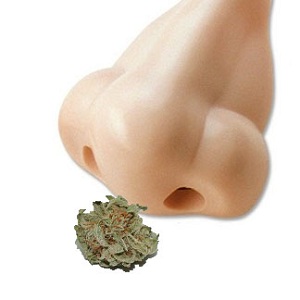Judge: “What else smells like marijuana, counsel?”
Attorney: “Is ‘smells like marijuana’ a valid perception by police?”
The problem is that “smells like marijuana” reports are entirely an unverifiable subjective opinion. It is unverifiable because even if marijuana is found that might be a function of random chance as opposed to olfactory detection.
Smell is one of the most amazingly individual senses that we can have. It is also hugely subject to confirmation bias.
The ability to validly and reliably detect through one’s nose the presence of cannabis is a very difficult metric to measure. Unlike specially trained canines, with humans there are no standardized methods (such as those outlined in SWGDOG) or training (such as those outlined in SWGDOG) or methods to track and verify an officer’s olfactory senses. It becomes an act of faith and a true ipse dixit.
So what are we left with? A human. With a nose. Who sniffs.

As a human who partakes in no specialized training, using no developed method, and having no method of compiling statistics, the validity of the perception depends on so many variables that it becomes as exercise in futility just to try to list them all. Things such as windage, environment, length of alleged exposure, maturity of the plant, age of perceiver, gender of perceiver, distance of the of perceiver, physical health of the perceiver, experience with marijuana by the perceiver, was it burnt or unburnt that they thought that they smelled, what is the perceiver’s odor threshold for marijuana (i.e., the individual’s odor threshold), and the list goes on and on ad nauseum with no clear sight at the end.
Although I have no data to support it, I strongly suspect that the “smells like marijuana” suffers from not simply inter-rater issues, but intra-rater issues. That is two people exposed to the same smell may not come to the same conclusion. And the same person exposed to the same smell at a later time may not come to the same conclusion.
Remember, “smells like marijuana” is not a perception that is based upon olfaction of pure chemicals. The “Cannabis smell” is most likely the terpenes (beta-caryophyllene (BCP) which is what canine trainers train their dogs to look for when they are trained to look for marijuana) that give its smell. But terpenes are very common. Researchers have identified more than 200 terpenoids in Cannabis. The most common and most studied include limonene, myrcene, alpha-pinene, linalool, beta-caryophyllene, caryophyllene oxide, nerolidol and phytol. Some of the smells may not even come from the plant itself but rather come to the plant due to aspects that are part of the process of cultivation or collection, or transportation of the plant through commerce such as bat guano to heavy salt-hydroponic fertilizers, and perhaps even chlorophyll.

This is not to take into account the human factors aspect of cognitive bias. A study in olfactory detection by van Langenhove & Schamp in 1989 (Van Langenhove, H., & Schamp, N. Encyclopedia of environmental control technology (Vol. 2, pp. 935–963) Houston: Gulf Publishing.) of PURE chemicals (N.B., cannabis is not a pure chemical), the researchers found and modelled the risk involved of false positive detections. This means that people reported smelling an aroma when in fact the aroma was not present, meaning they responded that they smelled something and definitively reported it as present while the smelling happened during what was supposed to be the study’s the controls or blanks period. Similarly there is the famous James experiment that was published in his book “The Principles of Psychology” in 1890. Professor James told a classroom of students that he was about to open a small bottle with a very strong odor in it, and that they were to raise their hands when they first noticed the smell. A few minutes after removing the bottle top, students in the first rows of the lecture hall began raising their hands, and in a matter of minutes the whole room was filled with raised hands. In fact, the bottle had no discernible smell, containing only the vapors of distilled water and a dying agent used to the make the water look dark. An amazing false positive rate of 100%.
I have been told that many products and natural phenomenon “smell like marijuana” such as Axe Body Spray, garbage, marigolds, a skunk, skunk cabbage, hops (as in what it used to make lager), and many other things.
There is a paper in the peer review that talks about this. It is entitled “Marijuana Odor Perception: Studies Modeled From Probable Cause Cases” and was published in Law and Human Behavior, Vol. 28, No. 2, April 2004 (2004) by Professor Doty et al. The authors write: “The present findings throw into question, in two specific instances, the validity of observations made by law enforcement officers using the sense of smell to discern the presence of marijuana. Although these instances reflect a very small set of studies with very specific constraints, they do suggest that a blanket acceptance of testimony based upon reported detection of odors for probable cause is questionable and that empirical data to support or refute such testimony in specific cases is sorely needed.”
So before we all go taking the reported perception of the police officer of “it smells like marijuana” as gospel, we should all consider these things.


